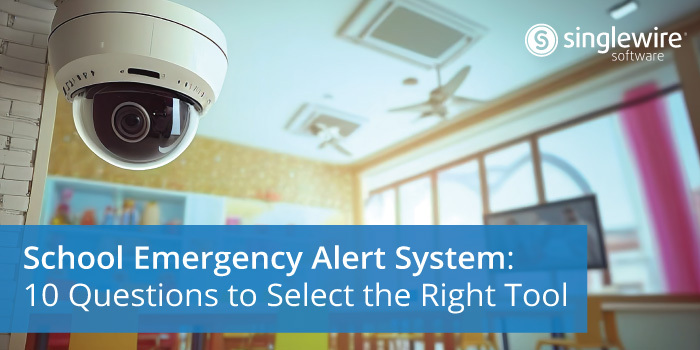Choosing the Best School Emergency Alert System
Every school is looking for a better way to alert students and staff about emergencies. But with so many solutions on the market, it’s hard to know where to begin looking. The size of a school, its location, and the unique threats or disruptions it may encounter can all impact how effective a solution is in informing everyone promptly and accurately during a crisis. In some cases, schools select a tool only to find out it only addresses some of their needs, and in others, schools add too many tools, creating an inefficient system that doesn’t work well during an emergency. In this blog post, we’ve compiled ten questions to help you choose the right school emergency alert system for your needs.
Key Considerations for a School Emergency Alert System
There are several key considerations you should weigh when choosing the right school emergency alert system. Each of the questions listed below will help determine if the solution you are considering will address all of your safety and communication needs.
1. Does it deliver alerts to on-site and mobile devices?
A comprehensive school emergency alert system should be capable of delivering alerts to both on-site devices and mobile devices. Emergencies can occur at any time, and it is vital to ensure that everyone, whether on school grounds or off-site, receives the alert. A system limited to one type of device risks missing critical individuals who may not be present at a specific location. The more communication channels a school can leverage, the more likely it is they reach all of their intended audience.
2. Can the staff customize these messages?
Customization of messages is a crucial feature in any school emergency alert system. Emergencies come in various forms, and the ability to tailor messages to specific situations can make a significant difference in response effectiveness. Whether it’s a fire, an intruder, or a weather-related event, customized messages provide the exact information needed, helping recipients understand and act accordingly. Schools may also have unique events that fall outside typical emergencies, so being able to use an alert system for non-critical events helps schools get more value out of their investment.
3. Does it integrate with existing school technology?
A school emergency alert system should integrate seamlessly with your existing technology infrastructure. Integration ensures that you can leverage current investments, avoid the costly process of replacing systems, and eliminate silos. A unified technology approach enhances efficiency and effectiveness, ensuring that all systems work together during an emergency. Typical integrations should include desk phones, paging systems, IP speakers, digital signage, desktop computers, and mobile devices.
4. Can it alert with text, audio, and visuals?
To ensure everyone receives the message, regardless of their location or what they are doing, a school emergency alert system should support multiple alert formats: text, audio, and visuals. This multi-faceted approach guarantees messages are intrusive so everyone sees, hears, and reads these alerts quickly, allowing for immediate action and response. In schools with students that have special needs, it also helps make alerts more accessible to everyone.
5. Does it offer incident management capabilities?
Sending alerts is just one part of managing an emergency. A robust school emergency alert system should include incident management capabilities. This means having tools that assist in coordinating the response, managing resources, and communicating with stakeholders. Effective incident management can significantly improve the outcome of an emergency by sharing real-time incidents and facilitating collaboration.
6. Can you reach the PSAP (Public Safety Answering Point)?
In certain emergencies, it is essential to notify external first responders promptly. The ability to reach the PSAP directly from your school emergency alert system ensures that officials bring first responders into the conversation quickly, providing them with the information they need to respond effectively. It also helps schools in states that have passed Alyssa’s Law meet the requirements of that legislation.
7. Can staff initiate alerts automatically?
In an emergency, every second counts. Automated alert initiation can be a game-changer. A school emergency alert system that integrates with sensors, weather service feeds, and other tools can automatically trigger alerts without the need for human intervention. This speed can be critical in situations where officials need to take immediate action.
8. Does the school emergency alert systems provide real-time insights?
Real-time insights are invaluable during an emergency. Features such as mapping (to identify an alert’s origin), AI video surveillance (to detect threats the moment they appear), confirmation response (to know who needs help), and virtual collaboration (to share information with stakeholders) are essential. These capabilities allow for a coordinated and informed response, improving overall safety and effectiveness.
9. Can officials use this system for more than emergency alerts?
Ideally, a school emergency alert system should offer value beyond just emergencies. Systems that can handle daily communications, such as announcements and bell scheduling, keep users familiar with the system. This familiarity ensures that when an emergency does occur, staff can use the system quickly and effectively. Additionally, it provides more value for the investment by being utilized regularly.
10. Does it eliminate the need for other systems?
A comprehensive school emergency alert system should help consolidate your technology landscape. By integrating various tools and potentially eliminating redundant systems, you create a streamlined process with only one system to learn and use during an emergency. This consolidation simplifies training and ensures a more efficient and cohesive response.
Selecting the right school emergency alert system involves carefully considering these critical questions. By ensuring the system can deliver alerts to all devices, customize messages, integrate with existing technology, provide multi-channel alerts, manage incidents, reach first responders, initiate alerts automatically, offer real-time insights, handle daily communications, and consolidate other systems, you can significantly enhance the safety and security of your school. For more information on selecting the right system, explore our InformaCast system, designed to meet the unique needs of schools and districts.
